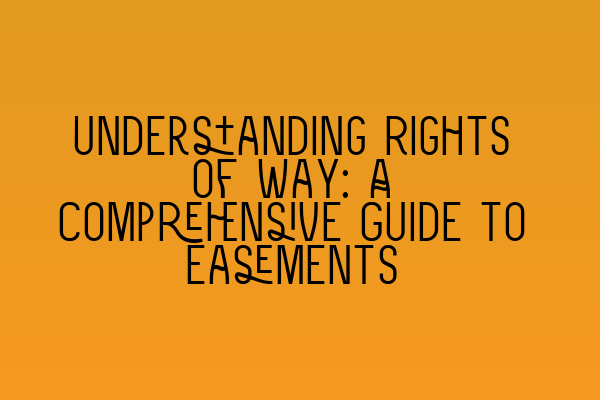Understanding Rights of Way: A Comprehensive Guide to Easements
Welcome to SQE Property Law & Land Law, your trusted source for legal information and advice. In this comprehensive guide, we will delve into the intricacies of rights of way, exploring what they are, how they are created, and what rights and responsibilities they entail.
What is a Right of Way?
A right of way is a legal easement that allows individuals to pass through or use someone else’s property for a specific purpose. It provides a legally recognized access route between two separate pieces of land, such as a main road and a landlocked property. Rights of way are commonly established for various purposes, including pedestrian access, vehicle access, or utility access.
Types of Rights of Way
There are two main types of rights of way:
- Public Rights of Way: These rights of way are recognized by law and can be used by the general public. They are often marked by footpaths, bridleways, or byways. Public rights of way are governed by legislation, such as the Highways Act 1980, and are typically maintained by local authorities.
- Private Rights of Way: These rights of way are granted to specific individuals or properties by the landowner. Private rights of way can be established through a written agreement or by long-term use over time. They are strictly limited to those granted access and are not available for public use.
Each type of right of way has its own legal framework and considerations, which we will explore in more detail.
Creating a Right of Way
In order to create a right of way, certain legal requirements must be met. The creation of a right of way can occur in several ways:
- Express Grant: A landowner can grant an easement for a right of way through a written agreement, such as a deed. This document will outline the exact rights, limitations, and responsibilities of both parties involved.
- Prior Use: If the right of way has been used openly and continuously for an extended period of time, it may be possible to claim an easement by prescription. This avenue requires proof of uninterrupted use and is subject to certain legal requirements.
- Necessity: In some cases, a right of way can be established based on necessity. This is typically the situation when a property is landlocked and requires access through another property in order to be usable.
The creation of a right of way is a complex legal process, and it is essential to seek professional advice to ensure the rights and obligations are clearly defined and legally binding.
Rights and Responsibilities
Whether you are the landowner granting the right of way or the individual benefiting from it, it is important to understand the rights and responsibilities involved:
- Landowner: If you are granting a right of way, you must ensure that the terms and conditions are clearly defined. This includes specifying the purpose of the right of way, the limitations on its use, and any maintenance or access restrictions. It is also crucial to consider the impact on your property and seek legal advice to protect your interests.
- Beneficiary: If you are benefiting from a right of way, you have the right to use the designated access route for the specified purpose. However, it is essential to use the right of way responsibly, respect any restrictions imposed by the landowner, and maintain the access route to prevent causing damage or inconvenience.
Understanding the rights and responsibilities associated with a right of way is vital to avoid disputes and ensure a harmonious coexistence between the landowner and the beneficiary.
Resolving Disputes
Unfortunately, disputes may arise concerning rights of way. Common issues include disagreements over the extent of the right of way, unauthorized use, maintenance responsibilities, or attempts to block access. When faced with a dispute, it is advisable to seek legal advice promptly.
Our team at SQE Property Law & Land Law has extensive experience in resolving rights of way disputes. We can help you navigate the legal complexities, explore potential solutions, and work towards a fair resolution.
For more information on related legal topics, we invite you to check out our other articles:
- Understanding Contractual Capacity: Rights and Limitations
- Interactive SQE Mock Tests for Contract Law: Test Your Knowledge
- Join Our SQE Contract Law Webinars: Expert Insights and Guidance
- Contract Law Reforms: An Analysis of Recent Changes
- Parties in a Contract: Rights and Responsibilities
The world of property law can be intricate and nuanced. With SQE Property Law & Land Law, you can rely on our expertise to guide you through any legal matters relating to rights of way and easements. Contact us today for professional legal advice and support.
